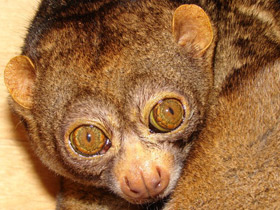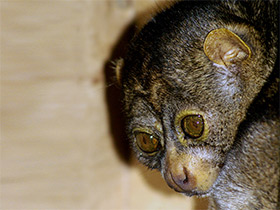The West African potto or Bosman's potto (Perodicticus potto)
The West African potto (Perodicticus potto) is a species of nocturnal strepsirrhine primate. It is found in tropical West Africa. It is also known as Bosman's potto, after Willem Bosman, who described the species in 1704. It is the type species of the genus Perodicticus.
Taxonomy
This species was formerly considered the only species in the genus Perodicticus, but a 2015 study split it into three species, with only the name Perodicticus potto only applying to the West African population.
Phylogenetic evidence supports the West African potto being the most basal member of the genus Perodicticus, with the other two species being sister species to one another. It is thought to have diverged from the other species during the mid-late Miocene, between 6-10 million years ago.
The mysterious "false potto" (Pseudopotto martini) is now thought to have been a misidentified specimen of West African potto.
Habitat area and peculiarities
Perodicticus potto is the only species of the genus Perodicticus. The origin of the name of these animals possibly comes from the African word pata, meaning tailless monkey.
There are only three recognised subspecies:
- Perodicticus potto potto;
- Perodicticus potto edwardsi;
- Perodicticus potto ibeanus.
Perodicticus potto is widely distributed in tropical rainforests and mountainous forests (up to 2600 m above sea level) in West, Central and East Africa (Cameroon, Nigeria, Guinea, Republic of Zaire, Kenya). They are usually found on the lower branches of tall trees or in the crowns of low trees at a height of 5 to 30 m and very rarely descend to the ground. Perodicticus potto moves slowly, like Nycticebus coucang, but they are more active than the latter. Externally, they are also similar to Nycticebus coucang, but have a small tail 6-8 cm long.
Appearance
Perodicticus potto is the largest member of the family, weighing up to 1.5 kg and measuring 35-40 cm in length. Perodicticus potto has a dense coat, especially that of the mountain subspecies, ranging from grey to various shades of brown; the lower parts of the body are lighter. The primate's limbs are short and coarse, with the hind limbs slightly longer than the forelimbs. The first fingers and toes are turned 180° in relation to the other toes. The second finger of the hand is reduced to a tubercle, the second toe has a grooming claw, the other toes have nails.
The face of Perodicticus potto is broad, with large, protruding eyes and small, rounded ears. The spinous processes of the first thoracic and last cervical vertebrae protrude strongly backwards, forming a tubercle on the neck surrounded by long hairs. The function of this formation is still debated. It is possible that it serves as a defence against enemies, and the Perodicticus potto tries to prick the enemy with these spikes by ducking its head towards the chest. It has been suggested that this amazing adaptation is intended to fix the Perodicticus potto in place while it sleeps, which is also highly questionable.
Lifestyle and nutrition
Perodicticus potto are nocturnal animals, sleeping in dense foliage during the day. Their movements are slow and cautious, but their grip is so strong that it is very difficult to pull them off a branch by force. Perodicticus potto has stable patches from which conspecifics of the same sex are actively pursued, however, male and female patches may overlap. The female plot ranges from 6 to 9 ha, and the male plot ranges from 9 to 40 ha. Unlike others, the Perodicticus potto feeds mainly on fruit, sometimes also on tree sap and insects. But in general its diet is quite varied: small mammals, birds and their eggs and chicks, small lizards, nuts, fruits and leaves.
Reproduction
Perodicticus potto seems to have two breeding seasons during the year. After a gestation period of about 170 days, the female gives birth to one young, rarely two. They first cling to their mother's belly, later to her back, or hide while foraging in the foliage. After about 4-5 months, the mother stops feeding them with milk, and at about 1.5 years of age, they reach sexual maturity. In captivity, the life expectancy is 26 years.
Ecology
One population of chimpanzees living in Mont Assirik, Senegal, was observed to eat West African pottos, taking them from their sleeping places during the day; however, this behaviour has not been observed in chimps elsewhere.
Conservation
Although this species is known to survive in disturbed forests near human habitation, population growth and subsequent habitat destruction in West Africa are of major risk to the species. Heavy deforestation for industrial agriculture is thought to have led to rapid population declines in the species. In addition, this species is more frequently hunted for bushmeat due to a decline in larger animals to hunt, which has in turn also caused pottos to become rarer. Due to this, it is classified as Near Threatened on the IUCN Red List.

















































